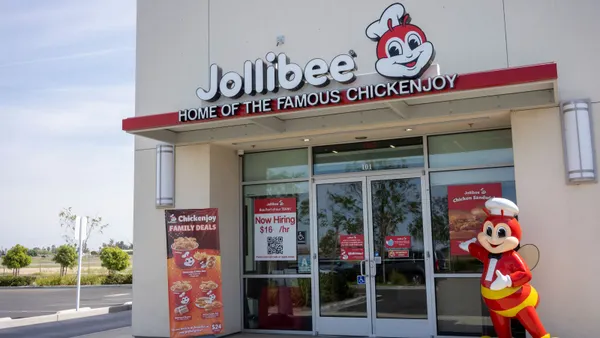Dive Brief:
- China’s e-commerce titan Alibaba and Hema, its semi-automated grocery store chain, has swapped robots for waiters at a high-tech restaurant called Robot.HE, which will open at the Shanghai convention center on Nov. 5, just in time for an international trade show. A version of the eatery opened earlier this summer, Business Insider reported.
- At the new restaurant, chefs will make the food and place it in the robot for delivery to the table. The robots will also clear plates after diners are finished, according to the Global Times.
- The Robot.HE restaurant that opened in the summer was located in a Hema Supermarket in Shanghai. There, customers choose seafood fresh from the grocery store, which is sent off to the system's refrigerator via robotic arms until they are ready to eat. Guests use a digital kiosk to connect their order to an open table. Once seated, they can use a mobile app to order side dishes. Kitchen staff cook the meals, but robot caddies deliver the dish. The cover opens when the robot, traveling on a sleek superhighway snaking through the restaurant, arrives at its destination.
Dive Insight:
Fast casual of the future won't eliminate the assembly line entirely: it might just be run by robots. Artificial intelligence and machine learning have transformed manufacturing, as robots no longer perform only menial tasks. In most cases, people work side-by-side with smart machines, and that marriage could translate to a dramatic shift in the way restaurants prepare and serve food.
Some businesses are beginning to test how robots can play a role in the industry. Culinary robot company Creator employs servers at its San Francisco restaurant, which opened in September, while a machine cooks and assembles $6 burgers. MIT grads and Silicon Valley entrepreneurs have also introduced robot-made grain bowls, pizza and burgers, driven by the promise of increased efficiency and lower overhead. In addition, San Franciscans can grab coffee from a robot’s arm at Cafe X, while Zume Pizza cooks pizza in automated kitchen vans driven by people. In Pasadena, Flippy, a short-order robot cook (or "autonomous kitchen assistant") cooks burgers and cleans up, and in Las Vegas revelers can order a robot-made cocktail through a tablet.
Despite recent instances of high-tech restaurant experiences, however, the technology might still be years — even decades — away from providing more than an average-tasting gimmick. Touchscreen ordering brings convenience to customers and speeds up the ordering process, but can robots take over an entire restaurant from kitchen to table, and everywhere in between? Right now bots can only perform certain tasks. Plus, analysts say, they are expensive to build and can malfunction at inopportune times.
Yet Americans seem to be enamored with the novelty and are willing to pay extra for the futuristic experience. Creator sold prepaid tickets this summer to try its machine-made burger, all of which sold out within hours, before opening to the public last month. The robot's owner says he was wanted to create a healthier kitchen space and, of course, improve efficiency. The machine grinds the beef to order, cooks and assembles the burger in five minutes.
Though Creator saves on some back-of-house labor, it still relies on people to make all of its sides, from fries to vegetables. Servers also take orders, pull the food off the machine and clean. But the idea of employing people for social and creative tasks that robots can't yet handle could gain traction as automation consumes low-skilled work. In restaurants, this setup allows employees to interact with customers. McDonald's, for instance, has said its kiosks help "repurpose labor." Employees now bring orders to the table and refill drinks, rather than just stand behind the counter.
Improving customer service could be a boon for U.S. restaurants, where Americans tend to like human interaction, but in China, consumers have been quick to embrace faceless shopping experiences and smart-home devices. This could explain why there has been more innovation — like Hema's more automated grocery experience — in the space overseas than domestically. Even a trend like conveyor belt sushi restaurants, introduced in 1958 to Japan, have only become more prevalent in the American marketplace in the past decade or so.










